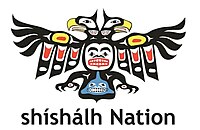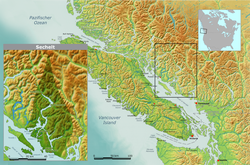 | |
 The shíshálh Nation swiya (world, "Territory") is located to the northwest of Vancouver, British Columbia (left inset) | |
| People | Coast Salish |
|---|---|
| Treaty | Non-treaty / shíshálh-B.C. Foundation Agreement (2018) |
| Headquarters | ch'atlich (Sechelt) |
| Province | British Columbia |
| Government | |
| Chief | hiwus/lhe hiwus |
| Council size | 4-5 |
| Council | hihewus
|
| Website | |
| www.shishalh.com | |
| People | shíshálh |
|---|---|
| Language | she sháshíshálhem |
| Country | shíshálh swíya |
The shíshálh Nation (also spelled Shishalh) is a First Nation located on the Sunshine Coast of British Columbia, Canada. Their swiya (world, 'Territory’) comprises 515,000 hectares that stretches from xwesam (Roberts Creek) in the southeast, to x̱enichen (Jervis Inlet) in the north, to kwekwenis (Lang Bay) in the southwest. [1]
Language[edit]
The language of the shíshálh people is she shashishalhem or Sechelt, a Coast Salish language most closely related to Squamish, Halkomelem, and Nooksack.[2] In the 1970s, nation elders began efforts to revive the she shashishalhem language. The band collaborated with University of British Columbia linguist Ron Beaumont to create a Sechelt Dictionary.[2][3]
Culture[edit]
tems swiya Museum[edit]
The tems swiya Museum is a cultural heritage museum owned and operated by the shíshálh Nation and located within their administrative complex in ch’atlich (Sechelt), British Columbia.[4][5]
History[edit]
Historically, there were four main shíshálh settlements at ḵalpilin (Pender Harbour), ts’unay (Deserted Bay), x̱enichen, and tewankw near alhtulich (Porpoise Bay).[1]
As the Europeans arrived in the region, the shíshálh people experienced numerous changes. Disease (especially smallpox) became rampant, and resulted in a severe decrease of the shíshálh population at their various ancestral settlements.[6]
Governance[edit]
Chief & Council[edit]
shíshálh Nation is governed by an elected Chief and Council. In she shashishalhem, the word for "chief" is hiwus, and the word for councilor is hihewus. The Nation holds an election every three years.[7]
Self-Government Act[edit]
In 1986, shíshálh Nation became the first indigenous government in Canada to regain self-government under the shíshálh Nation Self-Government Act (formerly known as the Sechelt Indian Self-Government Act).[8] The Act established the shíshálh Nation Government District (sNGD), a First Nations government district comprising 33 former "Indian Reserve" parcels, now known as 'shíshálh Nation Lands' or 'SNL'. The Act further enabled the sNGD to qualify for municipal benefits available to other municipalities in BC, such as to enact laws, bylaws, and taxes.[2]
BC Treaty Process[edit]
shíshálh Nation entered into negotiations independently with Canada and British Columbia under the BC Treaty Process in 1994, and reached Stage 3, Negotiation of a Framework Agreement, by August, 1995. Negotiations stalled thereafter in Stage 4 and the Nation is listed as "Not Currently Negotiating" by the BC Treaty Commission.[9]
shíshálh-B.C. Foundation Agreement[edit]
On October 4, 2018, shíshálh Nation and the Province of British Columbia signed a landmark reconciliation agreement that supports self-determination and shíshálh self-government. The agreement is a commitment to working together to protect the environment, as well as promote economic opportunity and growth for the shíshálh Nation and the entire Sechelt region.[10]
The agreement included the transfer of lands, as well as commitment to a framework of shared decision-making for forestry, moorages, and other land and resource authorizations within the shíshálh swiya.[11]
Demographics[edit]
- Number of Band Members: 1,237[12]
See also[edit]
Members[edit]
Pat John (1953-2022), actor in The Beachcombers
References[edit]
- ^ a b "shíshálh Nation Heritage Policy (k'ulhut-tsut ʔelh kwiyas)" (PDF).
- ^ a b c array. "she shashishalhem, The Sechelt Language". Shishalh Nation. shíshálh Nation, Sechelt, BC. Retrieved June 18, 2023.
- ^ Beaumont, Ronald C. (Ronald Clayton) (2011). "Sechelt dictionary". open.library.ubc.ca. Retrieved June 18, 2023.
- ^ "tems swiya Museum". www.sunshinecoastcanada.com. Retrieved June 18, 2023.
- ^ array. "shíshálh Nation tems swiya Museum | Sunshine Coast, Sechelt, BC". Shishalh Nation. Retrieved June 18, 2023.
- ^ "lil x̱emit tems swiya nelh mes stutula: A Strategic Land Use Plan for the shíshálh Nation" (PDF).
- ^ "shíshálh Nation prepares for 2023 election". Coast Reporter. January 23, 2023. Retrieved June 9, 2023.
- ^ Canada, Crown-Indigenous Relations and Northern Affairs (June 24, 2022). "Canada and shíshálh Nation mark Royal Assent of historic self-government legislation". www.canada.ca. Retrieved June 2, 2023.
- ^ "Sechelt Indian Band". BC Treaty Commission. Retrieved June 9, 2023.
- ^ webmedia (2018-10-17). "shishalh Nation and BC sign landmark agreement". Shishalh Nation. Retrieved June 9, 2023.
- ^ Forests, Ministry of. "shishalh and B.C. Shared Decision-Making". www2.gov.bc.ca. Province of British Columbia. Retrieved June 10, 2023.
- ^ "Sechelt Indian Band". Executive Council of British Columbia. 2009. Retrieved July 26, 2009.